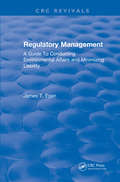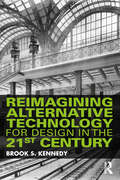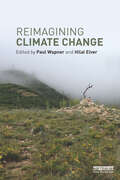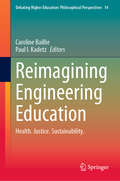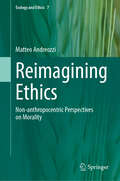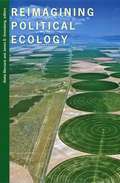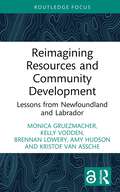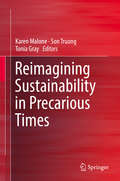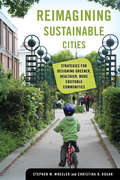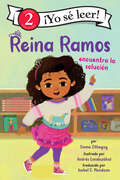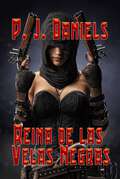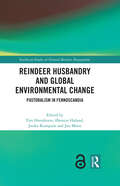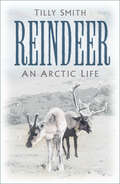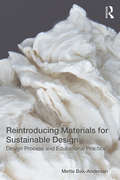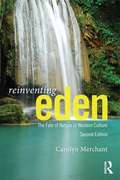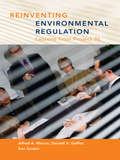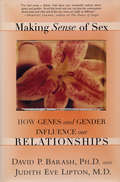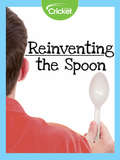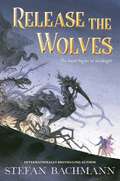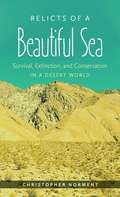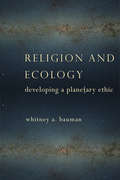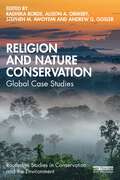- Table View
- List View
Regulatory Management: A Guide To Conducting Environmental Affairs and Minimizing Liability
by James T. EganRegulatory Management: A Guide to Conducting Environmental Affairs and Minimizing Liability emphasizes the importance of establishing a proactive approach to permit negotiation and compliance. This book is an important guide to conducting environmental affairs and minimizing liability. This book is a "must have" book for anyone responsible for regulatory compliance/management - private industry, environmental consultants, university officials, environmental engineers, environmental attorneys.Public and political concern about the environment has grown at a phenomenal rate over the last several years. Not since the early 1970s has there been such emphasis on reducing pollution. Congress and the Environmental Protection Agency have responded by enacting tough new legislation and increasing enforcement activities. Industry, utilities, and other entities that continue to discharge must invest millions of dollars in advanced waste treatment or face heavy fines or liability.In 10 detailed chapters, the author explains how to establish cooperative partnerships with politicians and regulators, create solution-oriented strategies using legal and technical permit insights, allocate resources to provide maximum environmental protection at minimum cost, reduce accidents and errors through training programs and procedure documentation, and influence the regulatory process to win practical and achievable permit limits. The book also shows you how to increase public credibility and manage the media, track treatment operations to provide a strong defense in the event of litigation, and keep up with new regulations and new technologies. The book is designed to help its readers set into motion the processes that will develop real solutions to environmental/regulatory challenges and will assist in developing an active and proactive management style that focuses on results as it minimizes liability.
Reimagining Alternative Technology for Design in the 21st Century
by Brook S. KennedyReimagining Alternative Technology for Design in the 21st Century presents a new approach to design that harnesses still-valuable alternative, traditional and abandoned technologies alongside the creation of new ones to address contemporary global problems. It focuses on design opportunities that reduce energy and material consumption to tackle issues such as climate change and pollution in industrialized economies. The book takes the reader on a journey surveying different facets of human activity to identify underused and discarded technologies that could be indispensable today. It critically addresses newer approaches to design and technology by comparing them to existing alternatives, unpacking examples including air conditioning with smart thermostats, electric lighting, durable reusable products, domestic maintenance tools and methods of transportation. Written for practicing designers and students in industrial design, architecture, sustainable design and human-centered design, this book provides new ideas and tools for creating more useful, energy-and-resource-efficient product designs and systems.
Reimagining Climate Change (Routledge Advances in Climate Change Research)
by Paul Wapner Hilal ElverResponding to climate change has become an industry. Governments, corporations, activist groups and others now devote billions of dollars to mitigation and adaptation, and their efforts represent one of the most significant policy measures ever dedicated to a global challenge. Despite its laudatory intent, the response industry, or ‘Climate Inc.’, is failing. Reimagining Climate Change questions established categories, routines, and practices that presently constitute accepted solutions to tackling climate change and offers alternative routes forward. It does so by unleashing the political imagination. The chapters grasp the larger arc of collective experience, interpret its meaning for the choices we face, and creatively visualize alternative trajectories that can help us cognitively and emotionally enter into alternative climate futures. They probe the meaning and effectiveness of climate protection ‘from below’—forms of community and practice that are emerging in various locales around the world and that hold promise for greater collective resonance. They also question climate protection "from above" in the form of industrial and modernist orientations and examine large-scale agribusinesses, as well as criticize the concept of resilience as it is presently being promoted as a response to climate change. This book will be of great interest to students and scholars of climate change, global environmental politics, and environmental studies in general, as well as climate change activists.
Reimagining Engineering Education: Health. Justice. Sustainability. (Debating Higher Education: Philosophical Perspectives #14)
by Caroline Baillie Paul I. KadetzThis book considers a radical change to engineering education. It argues for a reexamination of the traditional way in which engineering students are educated in disciplinary silos and how, instead, we might re-imagine their professional education to more appropriately prepare students to design innovative solutions to increasingly complex global challenges. It poses the question: “How can engineers think outside the engineers’ box?". A box that has over generations rendered engineers to be unquestioning servants of the socio-political systems in which they function. The book introduces a unique framework and language for engineering education which considers both the problems of the past and present, and the potential solutions offered for the future. By reaching out beyond the bounds of traditional knowledge and thought collectives, this book will also offer a pathway for other professional education programs to explore.
Reimagining Ethics: Non-anthropocentric Perspectives on Morality (Ecology and Ethics #7)
by Matteo AndreozziSeveral environmental problems are currently seriously undermining the traditional belief that the moral community should be restricted to human beings only. New scientific theories, especially in the fields of biology, ethology, and ecology, together with recent scientific discoveries demonstrating how human activities are jeopardizing ecosystem services urge for a paradigmatic change in our moral convictions. Environmental ethics has taken up the challenge and opened an extremely urgent and inspiring call for philosophical research. This is the call for extending the moral community to non-human and non-paradigmatic entities, regarding them as moral patients. The main aim of this book is to analyze the possibility and the legitimacy of a non-anthropocentric environmental ethic. In pursuing this aim, I primarily demonstrate the possibility and need to extend the status of moral patient beyond the ideal paradigmatic human being. I also provide an original categorization of several theoretical projects that have been proposed in the last few decades. Secondly, this book comprises a constructive critique of the most significant moral theories debated in the field and outlines a personal theoretical proposal for a new environmental ethic. My claim is that the refusal of ethical and ontological supremacy of human beings is not only necessary, but also sufficient to set the foundation for a formally and materially valid ethical system. Even without abandoning the most accepted forms of moral epistemology, it is nonetheless possible to admit the need to respect different kinds of non-human and non-paradigmatic moral patients.
Reimagining Political Ecology
by James B. Greenberg Aletta BiersackReimagining Political Ecology is a state-of-the-art collection of ethnographies grounded in political ecology. When political ecology first emerged as a distinct field in the early 1970s, it was rooted in the neo-Marxism of world system theory. This collection showcases second-generation political ecology, which retains the Marxist interest in capitalism as a global structure but which is also heavily influenced by poststructuralism, feminism, practice theory, and cultural studies. As these essays illustrate, contemporary political ecology moves beyond binary thinking, focusing instead on the interchanges between nature and culture, the symbolic and the material, and the local and the global. Aletta Biersack's introduction takes stock of where political ecology has been, assesses the field's strengths, and sets forth a bold research agenda for the future. Two essays offer wide-ranging critiques of modernist ecology, with its artificial dichotomy between nature and culture, faith in the scientific management of nature, and related tendency to dismiss local knowledge. The remaining eight essays are case studies of particular constructions and appropriations of nature and the complex politics that come into play regionally, nationally, and internationally when nature is brought within the human sphere. Written by some of the leading thinkers in environmental anthropology, these rich ethnographies are based in locales around the world: in Belize, Papua New Guinea, the Gulf of California, Iceland, Finland, the Peruvian Amazon, Malaysia, and Indonesia. Collectively, they demonstrate that political ecology speaks to concerns shared by geographers, sociologists, political scientists, historians, and anthropologists alike. And they model the kind of work that this volume identifies as the future of political ecology: place-based "ethnographies of nature" keenly attuned to the conjunctural effects of globalization. Contributors. Eeva Berglund, Aletta Biersack, J. Peter Brosius, Michael R. Dove, James B. Greenberg, Sren Hvalkof, J. Stephen Lansing, Gsli Plsson, Joel Robbins, Vernon L. Scarborough, John W. Schoenfelder, Richard Wilk
Reimagining Resources and Community Development: Lessons from Newfoundland and Labrador (Earthscan Studies in Natural Resource Management)
by Kelly Vodden Kristof Van Assche Monica Gruezmacher Brennan Lowery Amy HudsonThis book analyzes the experiences of communities facing major challenges relating to resource dependency and community sustainability, drawing on specific examples from the Canadian province of Newfoundland and Labrador. It offers a methodology of self-analysis for communities facing similar challenges, inspired by the ups and downs, local strategies for self-analysis, and collaborative work toward new futures in this Canadian province.Life in hundreds of small coastal settlements revolved around the cod fishery, until the fishery was no more viable. Communities have had to rethink their strengths, reconsider their assets, and imagine potential futures in the wake of events such as colonization and the collapse of the fishing industry. Their experiences are relevant for other parts of the world where formerly central resources are depleted or lose their value, and communities face the need for transition. The capacity to imagine different futures is rooted in the ability to critically consider strengths and weaknesses alike. The authors skillfully dissect and illuminate the conditions that can enable the reconsideration of local assets and narratives, toward a more sustainable future. The variety of these conditions, ranging from social memory to public debate, policy tools and institutional capacity, decision arenas, paths for participation, and distributed strategic leadership, are laid out clearly and illustrated vividly through vignettes written by individuals who participated in the events described. This book culminates in a flexible yet clearly structured method of self-analysis, useful for communities interested in rethinking their strengths and working toward new futures.This book will appeal to students, scholars, and professionals interested in community development and redevelopment and offers a new understanding of the mechanics of local and regional resilience
Reimagining Sustainability in Precarious Times
by Karen Malone Son Truong Tonia GrayThis book reflects the considerable appeal of the Anthropocene and the way it stimulates new discussions and ideas for reimagining sustainability and its place in education in these precarious times. The authors explore these new imaginings for sustainability using varying theoretical perspectives in order to consider innovative ways of engaging with concepts that are now influencing the field of sustainability and education. Through their theoretical analysis, research and field work, the authors explore novel approaches to designing sustainability and sustainability education. These approaches, although diverse in focus, all highlight the complex interdependencies of the human and more-than-human world, and by unpacking binaries such as human/nature, nature/culture, subject/object and de-centring the human expose the complexities of an entangled human-nature relation that are shaping our understanding of sustainability. These messy relations challenge the well-versed mantras of anthropocentric exceptionalism in sustainability and sustainability education and offer new questions rather than answers for researchers, educators, and practitioners to explore. As working with new theoretical lenses is not always easy, this book also highlights the authors' methods for approaching these ideas and imaginings.
Reimagining Sustainable Cities: Strategies for Designing Greener, Healthier, More Equitable Communities
by Stephen M. WheelerA cutting-edge, solutions-oriented analysis of how we can reimagine cities around the world to build sustainable futures. What would it take to make urban places greener, more affordable, more equitable, and healthier for everyone? In recent years, cities have stepped up efforts to address climate and sustainability crises. But progress has not been fast enough or gone deep enough. If communities are to thrive in the future, we need to quickly imagine and implement an entirely new approach to urban development: one that is centered on equity and rethinks social, political, and economic systems as well as urban designs. With attention to this need for structural change, Reimagining Sustainable Cities advocates for a community-informed model of racially, economically, and socially just cities and regions. The book aims to rethink urban sustainability for a new era. In Reimagining Sustainable Cities, Stephen M. Wheeler and Christina D. Rosan ask big-picture questions of interest to readers worldwide: How do we get to carbon neutrality? How do we adapt to a climate-changed world? How can we create affordable, inclusive, and equitable cities? While many books dwell on the analysis of problems, Reimagining Sustainable Cities prioritizes solutions-oriented thinking—surveying historical trends, providing examples of constructive action worldwide, and outlining alternative problem-solving strategies. Wheeler and Rosan use a social ecology lens and draw perspectives from multiple disciplines. Positive, readable, and constructive in tone, Reimagining Sustainable Cities identifies actions ranging from urban design to institutional restructuring that can bring about fundamental change and prepare us for the challenges ahead.
Reina Ramos encuentra la solución: Reina Ramos Works It Out (Spanish Edition) (I Can Read Level 2)
by Emma OtheguyThis popular Level Two beginning reader title about Reina Ramos dressing up for wax museum day at school is now available in Spanish translation. This Spanish-language book can be enjoyed by fluent Spanish speakers as well as those learning the language, whether at home or in a classroom.A Reina Ramos la emociona la idea de disfrazarse de Frida Kahlo para el museo de cera que se hará en su clase. Frida fue una persona de carácter firme, como la mamá y la abuela de Reina. Sin embargo, cuando Nora, su mejor amiga, también elige a Frida, Reina no sabe qué hacer. ¿De quién se irá a disfrazar ahora?Reina Ramos encuentra la solución es un libro ¡Yo sé leer! de nivel dos concebido para los niños que leen solos pero todavía necesitan un poco de ayuda. El libro incluye un glosario y una lista de personalidades famosas mencionadas en el cuento.
Reina de las Velas Negras
by P. J. DanielsSarah Chartimands es una capitana en un mundo mágico. Su barco: El Lady Flotsam. Su tripulación: piratas. Tras rescatar a un viejo amigo y mentor, Sarah se lanza a por el botín de su vida: el oro del Rey. Sin embargo, cuando no todo sale según lo previsto, se encuentra huyendo, superada en número y cuestionando su realidad; todo ello en una ciudad que intenta matarla. Esta aventura está cargada hasta los topes de pistolas, espadas y hechizos. ¿Podrá Sarah salvar un plan fallido? Y lo que es más importante, ¿encontrará la forma de salir viva?
Reindeer Husbandry and Global Environmental Change: Pastoralism in Fennoscandia (Earthscan Studies in Natural Resource Management)
by Tim HorstkotteThis volume offers a holistic understanding of the environmental and societal challenges that affect reindeer husbandry in Fennoscandia today. Reindeer husbandry is a livelihood with a long traditional heritage and cultural importance. Like many other pastoral societies, reindeer herders are confronted with significant challenges. Covering Norway, Sweden and Finland – three countries with many differences and similarities – this volume examines how reindeer husbandry is affected by and responds to global environmental change and resource extraction in boreal and arctic social-ecological systems. Beginning with an historical overview of reindeer husbandry, the volume analyses the realities of the present from different perspectives and disciplines. Genetics, behavioural ecology of reindeer, other forms of land use, pastoralists’ norms and knowledge, bio-economy and governance structures all set the stage for the complex internal and externally imposed dynamics within reindeer husbandry. In-depth analyses are devoted to particularly urgent challenges, such as land-use conflicts, climate change and predation, identified as having a high potential to shape the future pathways of the pastoral identity and productivity. These futures, with their risks and opportunities, are explored in the final section, offering a synthesis of the comparative approach between the three countries that runs as a recurring theme through the book. With its richness and depth, this volume contributes significantly to the understanding of the substantial impacts on pastoralist communities in northernmost Europe today, while highlighting viable pathways to maintaining reindeer husbandry for the future. This book will be of great interest to students and scholars of both the natural and social sciences who work on natural resource management, global environmental change, pastoralism, ecology, social-ecological systems, rangeland management and Indigenous studies.
Reindeer: An Arctic Life
by Tilly SmithIn this enchanting book, self-confessed reindeer geek Tilly Smith leads the reader through the extraordinary natural history of the reindeer with charming anecdotes about her own Scottish herd.From their flat ‘clown-like’ hooves to their warm furry noses and majestic antlers, fall in love with nature’s most adaptable arctic mammal.
Reintroducing Materials for Sustainable Design: Design Process and Educational Practice
by Mette Bak-AndersenReintroducing Materials for Sustainable Design provides instrumental theory and practical guidance to bring materials back into a central role in the design process and education. To create designs that are sustainable and respond to current environmental, economic and cultural concerns, practitioners and educators require a clear framework for materials use in design and product manufacturing. While much has been written about sustainable design over the last two decades, outlining systems of sustainability and product criteria, to design for material circularity requires a detailed understanding of the physical matter that constitutes products. Designers must not just know of materials but know how to manipulate them and work with them creatively. This book responds to the gap by offering a way to acquire the material knowledge necessary to design physical objects for sustainability. It reinforces the key role and responsibility of designers and encourages designers to take back control over the ideation and manufacturing process. Finally, it discusses the educational practice involved and the potential implications for design education following implementation, addressing didactics, facilities and expertise. This guide is a must-read for designers, educators and researchers engaged in sustainable product design and materials.
Reinventing Eden: The Fate of Nature in Western Culture
by Carolyn MerchantThis revised edition of Carolyn Merchant’s classic Reinventing Eden has been updated with a new foreword and afterword. Visionary quests to return to the Garden of Eden have shaped Western Culture. This book traces the idea of rebuilding the primeval garden from its origins to its latest incarnations and offers a bold new way to think about the earth.
Reinventing Environmental Regulation: Lessons from Project XL
by Alfred A. Marcus Donald A. Geffen Ken Professor SextonProject XL (eXcellence and Leadership) was the flagship effort by the Clinton administration for 'cleaner, cheaper, and smarter' regulation. Under Project XL, business promised better performance in exchange for a regulatory approach focused more on results than means, with the Environmental Protection Agency (EPA) measuring pollution reduction across rather than at individual sources within a facility. Reinventing Environmental Regulation is a compelling account of the breakdown in negotiations to implement Project XL at a tape manufacturing plant of 3M, a company widely recognized as environmentally progressive. Marcus, Geffen, and Sexton discuss the conflicting goals of participants, the influences of personality and organizational culture, and complications caused by changes in 3M‘s external business environment. They compare the 3M case with EPA negotiations involving Intel, Merck, and Weyerhaeuser, finding similarly contentious, though less fatal disagreements about the meaning of 'superior environmental performance.' In common with other recent proposals, Project XL emphasized cooperative, flexible regulatory approaches. Reinventing Environmental Regulation demonstrates the difficulty of putting these appealing ideas into practice, while offering encouragement for continued innovations.
Reinventing Nature?: Responses To Postmodern Deconstruction
by Gary Paul Nabhan Albert Borgmann Michael E. Soulé Kathryn Hayles Gary Lease Alan GussowHow much of science is culturally constructed? How much depends on language and metaphor? How do our ideas about nature connect with reality? Can nature be "reinvented" through theme parks and malls, or through restoration?Reinventing Nature? is an interdisciplinary investigation of how perceptions and conceptions of nature affect both the individual experience and society's management of nature. Leading thinkers from a variety of fields -- philosophy, psychology, sociology, public policy, forestry, and others -- address the conflict between perception and reality of nature, each from a different perspective. The editors of the volume provide an insightful introductory chapter that places the book in the context of contemporary debates and a concluding chapter that brings together themes and draws conclusions from the dialogue.In addition to the editors, contributors include Albert Borgmann, David Graber, N. Katherine Hayles, Stephen R. Kellert, Gary P. Nabhan, Paul Shepard, and Donald Worster.
Reinventing Prosperity: Managing Economic Growth to Reduce Unemployment, Inequality, and Climate Change
by Jorgen Randers Graeme Maxton&“An important contribution to the global debate about growth, equality, climate change, and the path to a viable human future.&” —David Korten, international bestselling author of When Corporations Rule the World The biggest challenges facing human wellbeing today—widening income inequality, continuing global poverty, and environmental degradation—may be simple to solve in theory. But, because we are required to come up with solutions that are acceptable to a political majority in the rich world, they are much harder to solve in practice. Most of the commonly proposed &“solutions&” are simply not acceptable to most people. Many of these proposed solutions—like stopping the use of fossil fuels—require a sacrifice today in order to obtain an uncertain advantage in the far future. Therefore they are politically infeasible in the modern world, which is marked by relatively short term thinking. In Reinventing Prosperity, Graeme Maxton and Jorgen Randers provide a new approach altogether through thirteen recommendations which are both politically acceptable and which can be implemented in the current period of slow economic growth around the world. Reinventing Prosperity solves the forty-year-old growth/no-growth standoff, by providing a solution to income inequality, continuing global poverty and climate change, a solution that will provide for economic growth but with a declining ecological footprint.Reinventing Prosperity shows us how to live better on our finite planet—and in ways we can agree on. &“An essential guide to those who want to change the world for the better—and for certain.&” —Ha-Joon Chang, international bestselling author of 23 Things They Don&’t Tell You About Capitalism &“[A] well-argued book . . . explaining complex issues in a style that is clear, logical, and succinct.&” —Publishers Weekly
Reinventing the Spoon
by Cricket MediaThe Bakeys company uses a simple recipe to make edible spoons in the hopes of cutting down on plastic trash.
Release the Wolves
by Stefan BachmannWhen a blacksmith’s apprentice witnesses a friend being killed by a legendary monster, he must decide between waiting for war in fear and silence, or risking everything to fight back. An extraordinary novel about friendship, tradition, obedience, and the monsters lurking behind every corner from internationally bestselling author Stefan Bachmann. For readers of Scary Stories for Young Foxes and Serafina and the Black Cloak.One thousand years ago, the Elduari conquered the country of Varen in a brutal war. Now, every few generations they subject their one-time enemies to a terrible tradition: bloodthirsty monsters are unleashed across the land, attacking indiscriminately, keeping the population in a perpetual dark age.For Argo, fear of another Release is something he has always lived with. When his friend is killed by a monster during a routine patrol, Argo suspects that another Release is coming, and sooner than everyone expects. But in a country built on fear, getting answers is dangerous. Elduari spies are hiding behind the most familiar faces, and any hint of disobedience could lead to the death of thousands.As whispers of dissent circulate, rebellion grows in the villages. Now Argo and his new ally, Ana—the King’s eldest daughter who is also a monster hunter in disguise—must decide whether or not to join the fight. But what if it’s already too late?From Stefan Bachmann, the internationally renowned author of The Peculiar and Cinders & Sparrows, Release the Wolves is an atmospheric, suspenseful, and haunting novel about friendship, family, power, and the monsters all around us.
Relict Species
by Jan Christian Habel Thorsten AssmannThis book provides an overview of the importance of research on relict species and presents conclusions and findings on the conservation of these species. There are relict species and populations from nearly all plant and animal groups and they contribute substantially to biodiversity across the globe. Current diversity patterns are influenced by both historic and recent ecological conditions. Relict species are of particular importance, as they usually suffer more severely from human activities than do non-relict populations; the situation is also potentially critical, as many relict species and populations have the potential to colonize large areas when the climate changes. The more than 27 contributions in this book highlight the history and status of today's relict species and populations and apply molecular genetics, morphometry, modelling and conservation biology to describe the past and present situations and to predict future trends of relict species' distribution.
Relicts of a Beautiful Sea
by Christopher NormentAlong a tiny spring in a narrow canyon near Death Valley, seemingly against all odds, an Inyo Mountain slender salamander makes its home. "The desert," writes conservation biologist Christopher Norment, "is defined by the absence of water, and yet in the desert there is water enough, if you live properly." Relicts of a Beautiful Sea explores the existence of rare, unexpected, and sublime desert creatures such as the black toad and four pupfishes unique to the desert West. All are anomalies: amphibians and fish, dependent upon aquatic habitats, yet living in one of the driest places on earth, where precipitation averages less than four inches per year. In this climate of extremes, beset by conflicts over water rights, each species illustrates the work of natural selection and the importance of conservation. This is also a story of persistence--for as much as ten million years--amid the changing landscape of western North America. By telling the story of these creatures, Norment illustrates the beauty of evolution and explores ethical and practical issues of conservation: what is a four-inch-long salamander worth, hidden away in the heat-blasted canyons of the Inyo Mountains, and what would the cost of its extinction be? What is any lonely and besieged species worth, and why should we care?
Religion and Development in the Asia-Pacific: Sacred places as development spaces (Routledge Research in Religion and Development)
by Matthew Clarke Anna HalafoffCommunity development is most effective and efficient when it is situated and led at the local level and considers the social behaviours, needs and worldviews of local communities. With more than eight out of ten people globally self-reporting religious belief, Religion and Development in the Asia-Pacific: Sacred places as development spaces argues that the role and impact of religions on community development needs to be better understood. It also calls for greater attention to be given to the role of sacred places as sites for development activities, and for a deeper appreciation of the way in which sacred stories and teachings inspire people to work for the benefit of others in particular locations. The book considers theories of ‘place’ as a component of successful development interventions and expands this analysis to consider the specific role that sacred places – buildings and social networks – have in planning, implementing and promoting sustainable development. A series of case studies examine various sacred places as sites for development activities. These case studies include Christian churches and disaster relief in Vanuatu; Muslim shrines and welfare provision in Pakistan; a women’s Buddhist monastery in Thailand advancing gender equity; a Jewish aid organisation providing language training to Muslim Women in Australia; and Hawaiian sacred sites located within a holistic retreat centre committed to ecological sustainability. Religion and Development in the Asia-Pacific demonstrates the important role that sacred spaces can play in development interventions, covering diverse major world religions, interfaith and spiritual contexts, and as such will be of considerable interest for postgraduate students and researchers in development studies, religious studies, sociology of religion and geography.
Religion and Ecology: Developing a Planetary Ethic
by Whitney BaumanMoving beyond identity politics while continuing to respect diverse entities and concerns, Whitney A. Bauman builds a planetary politics that better responds to the realities of a pluralistic world. Calling attention to the historical, political, and ecological influences shaping our understanding of nature, religion, humanity, and identity, Bauman collapses the boundaries separating male from female, biology from machine, human from more than human, and religion from science, encouraging readers to embrace hybridity and the inherent fluctuations of an open, evolving global community.As he outlines his planetary ethic, Bauman concurrently develops an environmental ethic of movement that relies not on place but on the daily connections we make across the planet. He shows how both identity politics and environmental ethics fail to realize planetary politics and action, limited as they are by foundational modes of thought that create entire worlds out of their own logic. Introducing a postfoundational vision not rooted in the formal principles of "nature" or "God" and not based in the idea of human exceptionalism, Bauman draws on cutting-edge insights from queer, poststructural, and deconstructive theory and makes a major contribution to the study of religion, science, politics, and ecology.
Religion and Nature Conservation: Global Case Studies (Routledge Studies in Conservation and the Environment)
by Radhika Borde Alison A Ormsby Stephen M Awoyemi Andrew G GoslerThis book presents a broad array of global case studies exploring the interaction between religion and the conservation of nature, from the viewpoints of the religious practitioners themselves. With conservation and religion often being championed as allies in the quest for a sustainable world where humans and nature flourish, this book provides a much-needed compendium of detailed examples where religion and conservation science have been brought together. Case studies cover a variety of religions, faiths and practices, including traditional, Indigenous, Buddhism, Christianity, Hinduism, Islam, Jainism, Judaism, Shinto and Zoroastrianism. Importantly, this volume gives voice to the religious practitioners and adherents themselves. Beyond an exercise in anthropology, ethnobiology and comparative religion, the book is an applied work, seeking the answer to how in a world of nearly eight billion people, we might help our own species to prevent the extinction of life. This book will be of great interest to students and scholars of nature conservation, environment and religion, cultural geography and ethnobiology, as well as practitioners and professionals working in conservation.
